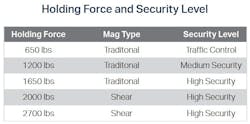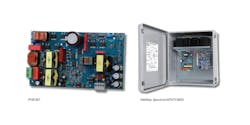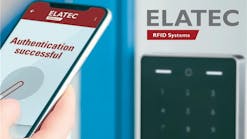Electromagnetic Locks – Proven, Long-Lasting Failsafe Security
The following is an update to an article from the September, 2017 issue of Locksmith Ledger magazine, “MagLock Holding Force – Security & Application.” In it, we concluded that “Electromagnetic locks are virtually problem-free as long as you follow the manufacturer’s installation instructions, and in most cases, allow the armature to be free to float.” Seven years later the same holds true today.
How Electromagnetic Locks Came into Existence
Prior to the 1970’s it was illegal to lock perimeter exit doors from the interior side. All that was permitted was an exit device to insure uninhibited egress at all times while locked on the exterior. This left facilities vulnerable to employee theft and also to breaking and entering by simply using a clothes hanger to unlock the exit device from the exterior. It was not uncommon to find exit devices on perimeter doors illegally chained and/or padlocked during certain times of the day or after hours.
In 1969, Locknetics founder Irving Saphirstein, designed the first electromagnetic lock that found approval for locking perimeter doors after business hours. Unlike an electromechanical lock, the electromagnetic lock had no moving parts to bind or wear, making it ideal for fire life safety applications that require the assurance of trouble-free release during normal operation, a power outage or by a signal from the fire life safety system.
However it took a while for this concept to be accepted by distributors for several reasons. It required a lot of current, had low holding force and required a special power supply to eliminate residual magnetism. Eventually improvements were made to eliminate these issues and several more companies, including SDC, began manufacturing electromagnetic locks.
Holding Force, Security and Application
Electromagnetic locks are appropriate for interior doors, perimeter exit doors and entrances that require failsafe emergency release capability. Depending on the level of security required they usually come in several levels of holding force. Electromagnetic shear locks are available in Concealed, Semi-Concealed and Surface Mount models to provide high security with a failsafe locking mechanism for openings that require an architecturally superior appearance.
Security Levels
Electromagnetic locks may be concealed (shear) or exposed (surface mount). Regardless of the configuration, careful concern should be given to the choice of holding force and the need for battery back-up when using electromagnetic locks for many access control applications. Manufacturers provide many choices available in different holding force and design applications.
Battery Backup
Battery backup is recommended to compensate for the inherent fail-safe operation in applications with higher security requirements, particularly on interior doors. When installed on perimeter doors, building and safety codes require magnetic locks to release during a building power loss and signal from the life safety system command center.
Surface Mount Electromagnetic Lock Application:
Traffic Control
Any magnetic lock with a holding force less than 1200 lbs. should only be used for traffic control, as would a light or medium duty electric strike. A holding force of 650 lbs. (see figure 1) is typical for most magnetic locks fit for traffic control and they may be easily defeated. However, this is a benefit compared to the use of light duty electric strikes. As the electric strike may break when forced, a low holding force magnetic lock will release without damage and the door will simply relock when closed.
Medium Security
Magnetic locks mounted on an aluminum glass door are capable of providing medium security because the glass door is more likely to shatter before a lock with 1200 lbs. (see figure 1) of holding force will release. For this reason, a lock with 1200 lbs. of holding force is sufficient for aluminum and glass openings and many commercial interior installations where aggressive attacks are not expected, such as openings made of metal frames and wood or hollow metal doors.
High Security
It is important to note that the term ‘high security’ is used only in the context of a fail-safe magnetic door lock application, which cannot compare to the integrity provided by electromechanical locking devices, such as fail-safe and fail-secure electrified locksets, electric deadbolts or heavy-duty electric strikes.
For most commercial and industrial high security applications with Herculite glass doors or hollow metal frames with wood or hollow metal doors, an electromagnetic door lock with at least 1500 lbs. (see figure 1) of holding force is recommended. When attacked with extreme force, these doors may not release, but may sustain damage.
While many installers may feel that 1200 lbs. of holding force is ample for any installation, it must be noted, that when these locks are overcome with force, the door will simply close and relock, with no one the wiser about the security breach.
For example, in psychiatric facilities, aggressive patients have been known to force open doors equipped with 1200lbs. holding force magnetic locks. It is not uncommon for some facilities to upgrade to a 1650 lbs. holding force electromagnetic lock after experiencing more than one breach.
Concealed (Shear) Electromagnetic Lock – Application
Shear magnetic shear locks (see figure 2) are generally used for openings that require an architecturally superior appearance. When installed on openings with hollow metal frames and wood or hollow metal doors, a magnetic shear lock with a holding force of 2000 lbs. or more is capable of withstanding a force that will deform or destroy the door beyond repair before it is released. However, when installed on glass doors, the contact point between the armature and magnetic lock will be exposed to tampering on both sides of the opening.
Shear locks have more critical alignment issues than typical surface mount magnetic locks. A valuable tip for trouble free shear lock installation is the use of a Positive Centering or Heavy Duty door closer for double acting aluminum glass and Herculite doors. Standard duty double acting door closers may tend to swing back and forth before resting and eventually become misaligned, requiring frequent adjustment servicing. To eliminate this problem, the installation of a heavy duty closer causes the doors to quickly rest in the center position and greatly reduce service calls. This is something that can be installed easily by most locksmiths or door professionals.
Semi-Concealed (Shear) – Application
Semi-Concealed Shear magnetic locks (see figure 3) accommodate offset hung glass doors, plus they provide a high security alternative to standard surface mount magnetic locks when used on hollow metal frames with wood or hollow metal doors. At the same time, they still provide superior appearance while the magnet is concealed in the frame and only the small armature housing is surface mounted to the top of the door.
Surface Mount (Shear) – Application
Almost half the size of a typical surface mount electromagnetic lock, surface mount Shear magnetic locks (see figure 4) provide a higher level of security for glass doors or metal door and frames.
Overall Benefits of Electromagnetic Locks
Electromagnetic locks are the staunchest of failsafe units because there is no mechanism that can cause sticking and binding. The versatility of electromagnetic locks allows them to be used almost anywhere electric strikes and electric bolt locks are used, but with these feature advantages:
• Most secure device
• Most failsafe device, easily adapts to meet Fire Safety requirements
• Durability – no moving parts, minimally effected by overvoltage
• Minimal maintenance
• Well adapted to poorly fitted or poorly hung doors
Electromagnetic locks are virtually problem-free. Typically, problems arise right after installation. Ninety-five percent of the time, the problem is either improper voltage input or an improperly mounted armature. Be sure to follow the manufacturer’s installation instructions, and in most cases, allow the armature to be free to float.
The overall benefits of electromagnetic locks versus other electric locking devices are that they allow fire safety requirements to be easily met while providing security and access control for a building’s occupants. As always, consult the local Authority Having Jurisdiction (AHJ) for compliance requirements governing your door project.
Kerby Lecka | Director of Marketing, SDC
Kerby Lecka is marketing director at SDC – Security Door Controls. He can be reached at [email protected].






